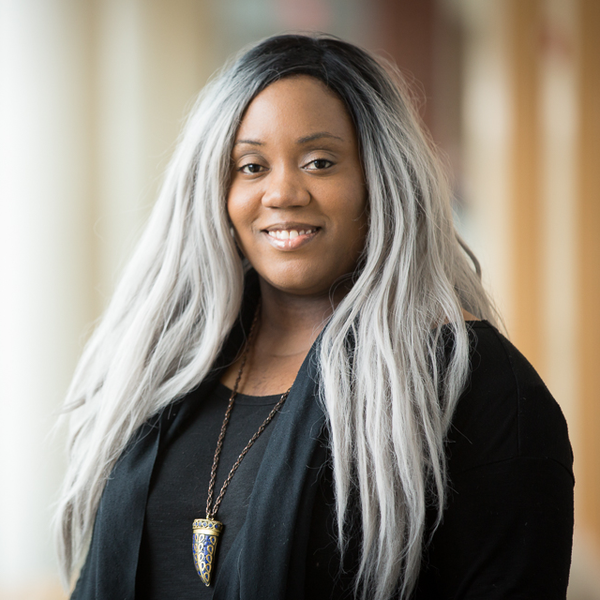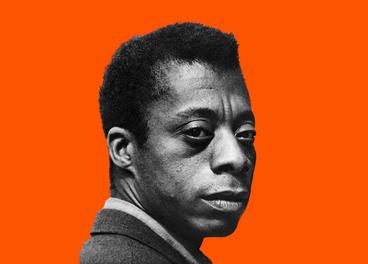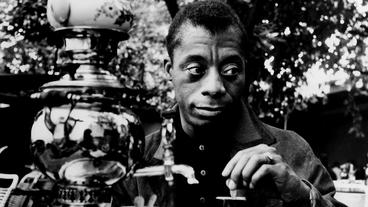
FEATURED ESSAY
The Weisman Art Museum’s collection contains primarily painting and sculpture of the United States. More Various, More Beautiful, and More Terrible, currently on view in the Woodhouse Gallery, is a reinstallation of a small portion of this collection. Senior Curator Diane Mullin’s original goal was to select artists from the collection that had not been exhibited often, or ever, at WAM. This aspiration was later guided by a quote from James Baldwin’s “A Talk to Teachers”, given in 1963 which served as the framework for the Woodhouse exhibit and the Weisman Art Museum’s larger accessioning and deaccessioning objectives. The full quote reads, “American history is longer, larger, more various, more beautiful, and more terrible than anything anyone has ever said about it.” The concept “various” is used, rather than “diverse”, to signal relational layers of identity. Instead of grouping artists sequentially or based on shared identity, the exhibit—which spans the twentieth and twenty-first century—displays pieces laterally, without preconceived hierarchy. The visitor is free to make connections between art from different movements and to locate recurring themes.
In this interview I talk with Dr. Megan Finch, an Assistant Professor in University of Minnesota’s English department, about her research on James Baldwin to expand and challenge how we can think with Baldwin at the Weisman Art Museum, and beyond.
Art & Unreason
Olivia M Comstock (OC): What is your relationship to art or to art museums?
Megan Finch (MF): I'm not a person who thinks with visual art a lot in my scholarship, but I did teach at Rhode Island School of Design as a Visiting Assistant Professor from 2019 to 2020. I’ve had interesting conversations with former students who are producing art inspired from the humanities work I’m more familiar with.
I’m always fascinated by how artists metabolize and use theory. One former student, whose work was recently acquired by the MET, spoke in an interview about how Afropessimism influenced their current artwork. It’s interesting to see how this theory translates into a visual context, which is very different from what Afropessimism might mean to me writing about it.
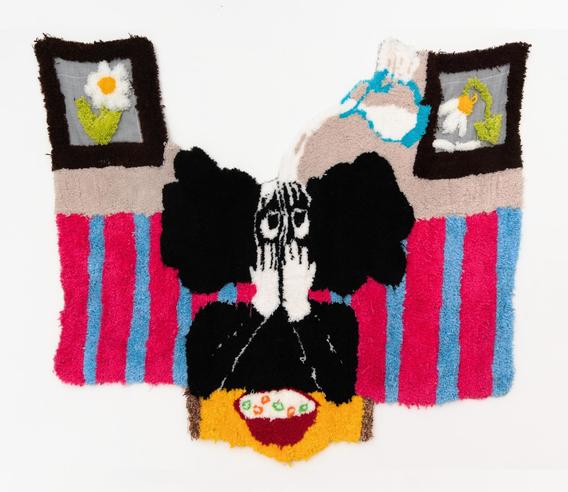
OC: Tell me a little bit about your scholarship.
MF: I am focused on Black women’s writing from 1970 to approximately 1990. My interest is in representations of unreason. Oftentimes this has been thought of, on a text-by-text basis, as madness. For example, I want to understand Toni Morrison’s representation of matricide alongside representations of maternal unreason and unreason more broadly in several texts from Black women of the period. Baldwin comes in here because the representation of unreason, often in the form of suicide, across several of his texts is something I often think about as I write about these Black women writing about “madness.” I put these writers in the context of feminist and Black power politics to understand how they are using these representations of unreason to negotiate their position as distinct from those “other” political formations.
OC: With madness, are you thinking of how that condition manifests in characters in these novels?
MF: I'm not so interested in madness at this point. I'm more interested in various forms of unreason that emerge in the Enlightenment—the work of John Locke, in particular. There are several forms of unreason that allow for political and social exclusion. Childhood is one example of this: the Child is unreasonable, but the Child will grow up and most likely become reasonable. The Criminal, the Madman, and the Idiot are other examples, but only the figure of the Idiot is a permanent, rather than temporary, form of unreason. I trace the use of idiocy alongside Locke's other “work” including his “Essay on Human Understanding” and the “Constitution of Carolinas.” I'm interested in thinking about how the representation of unreason in Black women’s literature has been traditionally thought of as madness. However, I suggest we might think about unreason in terms of “idiocy”, or a permanent incapacity for reason, as opposed to madness, which is a temporary disorganization of reason.
There are several forms of unreason that allow for political and social exclusion. Childhood is one example of this: the Child is unreasonable, but the Child will grow up and most likely become reasonable.
For instance, Sethe from Morrison’s Beloved, is characterized by killing her children. Instead of thinking about this as an extreme moment of mental distress, Sethe is animalized, from the perspective of the schoolteacher (i.e. scientific order imposed on Blackness). Madness becomes unavailable because Sethe is understood as mindless, without a mind to be disordered.
Entry Points, in Other Words
OC: Even though Baldwin is not your primary project, you recently had an article published in MELUS: Multi-Ethnic Literature of the United States titled “Baldwin’s (Afro)pessimism: Another Country as a ‘Colonized and Accultured Society.’” Can you talk a little bit about your approach to thinking with Baldwin broadly?
MF: This article is a very particular entrance point into the scholarly conversation around Baldwin’s novel and Afropessimism. When we think with Baldwin broadly, we're already defining Baldwin as a person with an established name who is worthy of our consumption. A renowned person who said things that mean certain things to us already. Everyone thinks of Baldwin from a particular point of entry. Baldwin as a literary artist is my usual entry point.
OC: You are talking about Baldwin’s work as having these different entry points but, of course, he is not the immutable figure we often think of him as. How does Baldwin’s text shift in the classroom vs. your public academic work vs. your scholarship?
MF: How I think about Baldwin shifts in those cases. For instance, when talking to a church group who has chosen to read Baldwin’s most heterosexual novel, If Beale Street Could Talk, and having done so in the wake of George Floyd’s murder, there are different considerations. While I want to be honest in each case about what I see in the text and not misrepresent that…it is not so much that Baldwin shifts, but what is possible in each context.
We can apply “more various” to Baldwin himself (and most scholars). He has so much written work for different venues—speeches, novels, columns, poems, plays, and essays. Cohesion is not only impossible but also probably not desirable over a long period. Baldwin wrote across the protest novel-era, the Civil Rights movement, the Black power movement, and Ronald Reagan.
Baldwin's Masculinity & Black Lifeworlds
OC: Can you talk a little bit about the essay “Baldwin’s (Afro)pessimism: Another Country as a ‘Colonized and Accultured Society’” that you wrote?
MF: It emerged from the mundane academic observation that Baldwin’s Another Country is a novel that centers the last day of the life of its “central” Black male figure, Rufus. He commits suicide, or is “taken by the wind,” about a quarter of the way into the novel. The rest of the novel shifts to the focal points of the sister and friends who survived him.
I argue that this structure results from the fact that it is the first novel where Baldwin represents what I call a “colonized and acculturated society”, meaning an interracial cast of characters. The first novel focuses on Black lifeworlds. There's white violence, of course, but it's around the edges of a novel focused on Black life. Giovanni's Room is about white people (this is a critically complicated claim, but I mean this in the most literal sense). Another Country is the first time where white and Black life comes together.
Some of the questions around representing the human that were so central to Baldwin are put in relief when he tries to represent Black and white people together, as human agents of legible desire.
In the essay, I discuss the novel’s inability to represent Black humanity and white humanity within the same frame (in terms of an Afropessimist understanding of antagonism) which causes this novel to take on this two-part structure. Even though Afropessimism developed much later, in 2010 with Frank B. Wilderson’s Red, White, & Black, we can read an analysis of the exclusion of Blackness beginning with Frantz Fanon, who was a contemporary of Baldwin.
OC: One of the television specials I wanted to screen was Nikki Giovanni in conversation with James Baldwin on “Soul” in 1971, but it was too long to include. I think Giovanni in that special really challenges Baldwin. It highlights gender but also generational dynamics. Because you also work on Black women’s literature, what do you think Baldwin’s limitations are when it comes to gender?
MF: It comes across most starkly in the novels, but you see it certainly in the conversation with Nikki Giovanni and Audre Lorde through his deployment of terms like “masculinity” and “manhood.” Sometimes we take the second term to be a general stand in for personhood, but it is not for Baldwin. He actually means “man.” He's interested in Black masculinity and this has a lot to do with his representation of sexuality.
Whereas a man can be emasculated, there isn’t anything equivalent for him for women. What women lose in his writing are men.
For instance, in Giovanni’s Room, there is a very independent female character. As soon as the main character David sleeps with her, she clings to him in ways that betray any sense of her independence. Baldwin’s novels are about freedom and courage for men within the framework of masculinity to live a human life outside of various categories and expectations. One way of living courageously is being with other men in the face of the social stigma and the violence that occurs. There is nothing equivalent for his female characters. There are no lesbians. Women are there to support masculinity.
OC: What do you think about the way Baldwin’s words are being mobilized or conjured in the present moment?
MF: I want to revise something I previously said in an interview about Baldwin. I have been at the University of Minnesota since Fall 2020 and taught American literature, including African American writers.
At times, I have found it difficult to engage students in a discussion of the Black literature as literature, as opposed to documentaries about how terrible Black life is. It makes it difficult to do my job, because I am a literary scholar who is interested in the arguments literature makes as literature.
I want to engage the text in the classroom. What students are taking from the page sometimes isn’t there or isn’t all that’s there. It struck me as similar to the way that lines from Baldwin get extracted from their contexts and put on Instagram, twitter, or posters. I don’t want to reify James Baldwin as a figure that has to be taken in a certain way, and so I accept that people will use his words in different ways. Who am I to tell anybody what they should or shouldn’t do with these words, or with anyone’s words, if they find them useful.
I may have been frustrated before about what the extraction of his words from their context does, the ways in which it doesn't consider genre, form, or intent, but now I just don’t know how much that matters outside of literary scholarship.
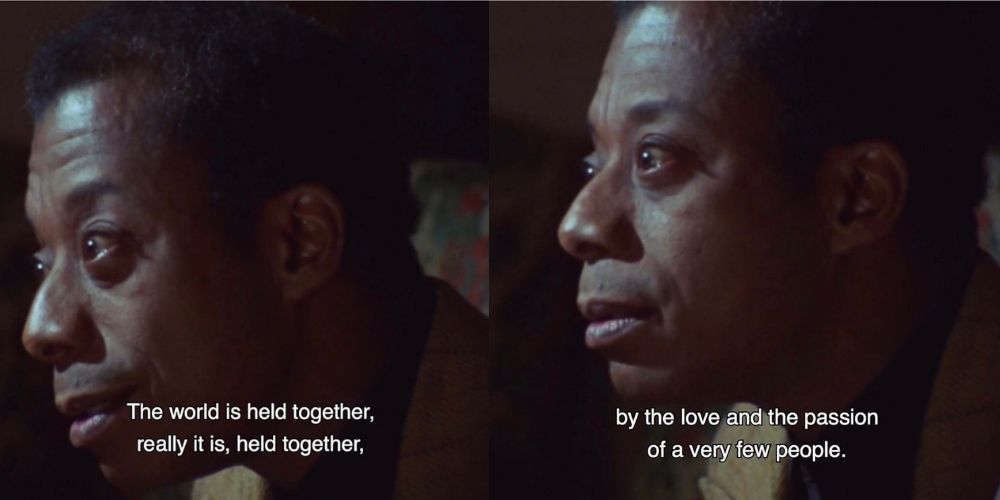
James Baldwin wrote beautiful prose that people monumentalize. While I do think it is a limited way of understanding Baldwin, that was always going to be the case.
You could read everything Baldwin wrote and still just have words on paper. Whatever amount of writing anyone leaves behind is nowhere near the totality of who they were or what they thought.
Thinking With Baldwin
OC: How can we think with Baldwin instead of just repeating his words?
MF: I don't want to just be repeating his or anyone's words, but repetition is always a repetition with difference. Invoking Baldwin in 2024 is very different from that invocation made at any other time.
If you want to think beyond a single quotation and engage, then the thing you can do is read Baldwin.
At the very least, if you find a quote you think is brilliant, find the essay it came from and read that. Thinking with Baldwin might mean reading the text and trying to get a sense of historical context.
OC: Bringing it back to the exhibition, how can we think with Baldwin about American art?
MF: The concept of the exhibit and using Baldwin’s “Talk to Teachers” as a framing device is an interesting way of abstracting Baldwin. He was very interested in art in a broad sense, not just visual art. Several of the novels have central figures who are literary (Vivaldo from Another Country), performance (Leo from Tell Me How Long the Train’s Been Gone), musical (Rufus from Another Country and Arthur from Just Above My Head), or visual artists (Fonny from If Beale Street Could Talk).
OC: This question makes me think about Baldwin's complicated relationship to the United States. One thing that struck me reading No Name in the Street is how he writes about America with great criticality and almost care and love at the same time.
MF: Baldwin often wrote about himself as an American and enfolded himself with other Americans using the first-person plural pronoun “we” in his essays. When his characters are set in France, where he spent much of his life and died in 1987, they are constantly thinking about America and the difficulty of being a man (Black or white) in America.
If one thinks change is possible and cares about and loves something enough to want that change to come to fruition, incisive critique is a necessary step.
Dr Megan Finch
Dr. Megan Finch’s research focuses on the relationship between Enlightenment/racial slavery era discourses on reason and blackness. More specifically, her current work focuses on how late 20th-21st century literature by black women mobilizes these discourses to contest the figure of the "mad black woman” and contemporary definitions of reason.
Photo Credit: Simon Goodacre for Brandeis University
